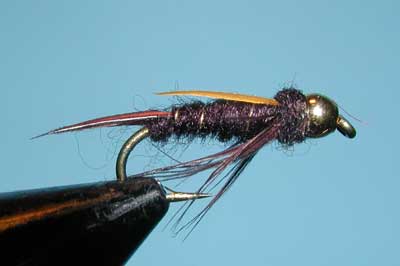Harts Dark LordThis nymph, a variation of the Prince nymph, was created by a MT. Shasta guide, Ron Hart in 1986. It became quite popular within the northern sierra during the mid-1990’s and the popularity of this nymph seems to be growing as yet. The Dark Lord tries to imitate the natural nymphs by utilizing darker colors yet still retains the contrast of the wings to the body – the same character that makes the Prince Nymph quite effective as an attractor nymph. The wings are a ginger color which imitates the naturals and contrasts well against the black body. The gold wire ribbing offers a segmented appearance. The black hen hackle fibers are tied in small bundles downward on each side of the thorax to give the appearance of legs. Ron’s original pattern uses stiffer neck hackle fiber extending to the base of the tail for the legs. Some variations of this pattern will apply the legs by wrapping a neck hackle twice, trimming off the upper fibers.
Ron Hart / FLYFISHINGTHESIERRA.COM
Translated by Carl Wuebben
PATTERN
HOOK – TMC 3761 or equivalent in sizes #12 - #16
THREAD – Danville black 6/0 or equivalent
BEAD – Gold bead
WEIGHT – Lead or non – lead (diameter of hook shank)
TAIL – Brown goose biots
RIB – Gold wire
BODY – Black rabbit dubbing
COLLAR – Black rabbit dubbing
LEGS – Black hen cape hackle fibers
WING – Amber goose biots
HOW TO TIE
- Debarb hook – slide the gold bead onto the hook with the small hole first then move it up against the eyelet and mount in the vise. Attach three wraps of lead or non lead wire on the hook shank and slide it up into the bead hole.
- Start your thread in behind the bead and lay down a thread base to just above the hook barb area. Make a small dubbing noodle by twisting some black rabbit dubbing between your thumb and index finger (just a little) and wrap the noodle to form a small butt to help split the tail biots (this keeps the tail spread out).
- Select two brown biots and tie them in tips rearward just in front of the butt dubbing by doing one at a time and crossing over the shank top and in the front of the butt dubbing to give you a “X”. The tail should be about half the hook shank out the rear. Now clip off the butt ends of the biots and wrap forward to about midshank.
- Grab a hunk of gold wire for the ribbing and tie it in on the side near of you and with your thread wrap the wire down rearward to the dubbing butt. If any of the wire tag ends you can’t wrap over just clip it off. Leave the wire hanging rearward for now.
- Make another dubbing noodle (but larger) with the black rabbit dubbing and wrap it forward making a tapered body almost to the bead leaving a small space for anchoring the wings and legs.
- Wrap the ribbing forward about 4 – 5 wraps and secure it just behind the bead. Clip the wire tag end off.
- Pull two bundles of hen hackle fibers from a feather and attach to one side of the fly behind the bead. Now do the same for the other side. The fibers should not extend beyond the bend of the hook and should sweep rearwards in a downward position by putting some thread wraps over the fibers to help brush them rearward. Clip any tag ends off.
- Attach each ginger biot behind the bead criss crossing like the tail and with a downward curve and the split angle being about the same as the tail. Clip the wing biot tag ends off and put some wraps on to secure the wings.
- Make another small dubbing noodle with the black rabbit dubbing and wrap a collar behind the bead then whip finish and clip your thread.
TIE UP A DOZEN OR TWO – AND GO FISHING*** But remember to practice C.P.R. (CATCH – PICTURE – RELEASE)


